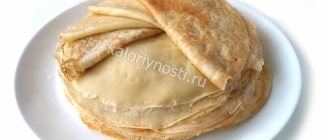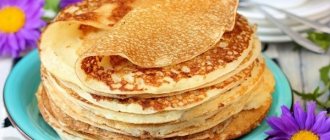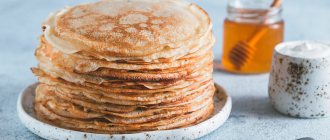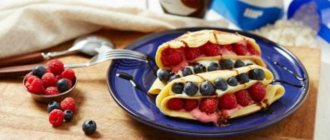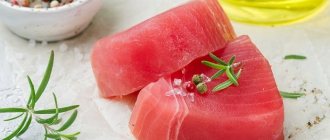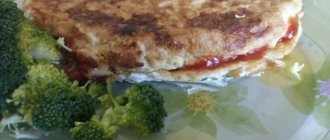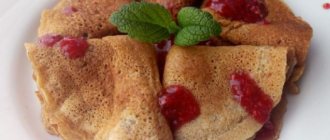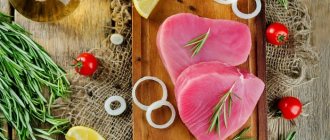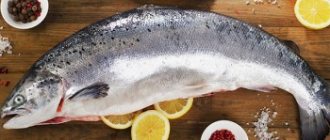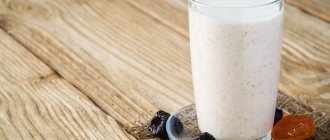Sometimes, on the eve of the summer months, vacations and open outfits, it is necessary to reduce the calorie content of familiar dishes. Today we will find out what the calorie content of pancakes with water is, because despite the fact that they almost do not differ in taste from milk or kefir, they contain noticeably less fat!
But since not everyone may like replacing fermented milk products in the dough, we will also tell you how to still keep such baked goods no less appetizing.
Calorie content of pancakes with milk: how many calories are in 1 pancake
Pancakes are a traditional dish of national Russian cuisine. They are very popular not only among residents of Russia, but also in many countries around the world. There are many recipes for making pancakes with different fillings and ingredients. Most often, the traditional recipe uses wheat flour, milk and eggs. The number of calories in such a dish will certainly puzzle supporters of a healthy diet. For this reason, many people try not to cook delicious pancakes for fear of gaining excess weight. How many calories are in milk pancakes and how much does 1 such pancake weigh?
Quick pancakes (no sugar).
Here are another quick pancakes, we will make them without sugar, since we eat them with condensed milk or jam. This is for those who can't eat too much sweets.
We will need:
- Milk - 500 ml;
- Egg - 2 pcs;
- Vegetable quantity - 50 ml;
- Flour;
- Salt to taste.
Step 1.
Mix all ingredients immediately in a deep bowl and stir. We usually do this with a mixer, or you can just whisk everything.
Step 2.
Now heat up the pan and grease it with a little oil for the first time. Then you don't have to lubricate it. If it burns a little, add more oil to the dough.
Step 3.
Fry the pancakes on both sides over medium heat until golden brown.
When ready, roll the pancakes into a triangle, pour condensed milk over them and have breakfast.
Pancakes with milk and water
If you prepare pancakes according to the classic recipe, then they should be fried in oil or lard. Such pancakes turn out to be fatty , and if you take into account the various fillings, the calorie content of the dish will be very high. The filling can be made from many products, but most often it is:
Pancake dough can be prepared not only with milk, but also with water, due to which the calorie content of the dish will be lower. The taste of the finished product will depend on the composition of the ingredients. Unfilled pancakes will contain:
- vitamins B and PP - useful for the functioning of the nervous system and necessary in conditions with increased physical activity;
- potassium and sodium – improve kidney function, regulate water metabolism;
- iron – will increase the level of hemoglobin, an essential component of respiratory enzymes;
- phosphorus and magnesium - regulate the functions of the heart, blood vessels and nervous system, improve bone condition.
pancakes in case of obesity , in the stage of exacerbation of the digestive system, or diabetes mellitus.
Lace
The cakes turn out lacy, with small holes. This appearance is achieved due to the fact that the pancakes are prepared using specially beaten eggs, the holes form air bubbles that are evenly distributed throughout the pancake dough.
Ingredients:
- two eggs
- one glass of boiling water
- one glass of milk
- one glass of flour
- two tablespoons of sunflower oil
- one teaspoon of salt.
Pancakes recipe:
- Salt the eggs and beat. Salt is needed to help the eggs beat better.
- Continuing to beat, add a glass of just boiled water. Eggs should foam better in hot water.
- Add flour in small portions.
- Add milk to the dough.
- Before baking, add vegetable oil.
Bake in a hot frying pan greased with a small amount of vegetable oil.
Calorie content of pancakes with milk
Pancakes are easy to prepare, all you need is time, desire and the necessary ingredients:
- eggs;
- milk;
- Wheat flour;
- salt and sugar;
- vegetable oil.
All ingredients are mixed until a homogeneous mass without lumps is formed. Pancakes are fried in a hot frying pan until browned. The calorie content of pancakes according to this recipe per 100 grams of product will be 170 calories , of which:
- proteins – 4.8 g;
- fats – 7.1 g;
- carbohydrates – 22 gr.
On average, 1 pancake will weigh approximately 50 grams without filling, and the calorie content is 1 piece. will be 85 calories.
The calorie content will be much higher if fattier milk is used to prepare the dish. Sugar is also and its amount affects the calorie content.
The calorie content of a popular dish can be reduced by using other ingredients instead of milk, for example:
- pancakes on water: calorie content per 100 grams – 135 kcal; 1 piece – 67.5 kcal;
- pancakes with beer: calorie content per 100 grams – 163 kcal; 1 piece – 81.5 kcal.
How can you reduce the calorie content of pancakes?
Everyone who cares about their figure tries to consume less high-calorie foods in their daily diet. Experienced nutritionists and chefs share with us their useful tips and recommendations. They will help you cut down on calories and make delicious pancakes.
If you have a non-stick frying pan, you can use minimal amounts of oil . You need to add a couple of tablespoons of vegetable oil to the dough and then fry the pancakes in a heated frying pan, even without oil.
Using eggs for dough, you can take only whites, which contain virtually no fat.
Milk can be diluted halfway with water, and then the pancake dough will taste good and have less calories.
To prepare the dough, you can mix wheat flour with wholemeal flour, which has fewer calories. The resulting dough will be healthier, because it contains more vitamins and fiber.
It is better not to use jam or condensed milk for the filling. Instead of sweet fillings, it is advisable to use fruit and berry purees, which will help to significantly reduce the nutritional value of the finished dish.
Prepare pancake dough without milk, for example, with water. Of course, such pancakes will not be as tasty, but they will contain fewer calories.
Another little trick is to fry very thin pancakes , then you can eat not 1 or 2, but for example, 3-4 pieces. If you put pancakes in a small plate, the portion will look large.
What makes pancakes tastier and how many calories are in them?
Pancakes are usually eaten as a main course, snack or dessert. To ultimately get lower calorie content, it is better to use fermented milk products instead of milk:
It is believed that the use of fermented milk products has a better effect on health. Pancakes cooked in water will have the lowest calorie content. Many filling products can be combined with pancakes . The calorie content of the finished dish will depend on the type of dough and filling products used. Let's consider several options for pancakes with calorie content per 100 grams:
- with sour cream and cottage cheese – 312 kcal;
- with beef meat – 250 kcal;
- with mushrooms – 218 kcal;
- with red caviar - 324 kcal;
- with salmon – 313 kcal;
- with eggs – 222 kcal;
- with honey – 350 kcal;
- with butter – 332 kcal;
- with baked apples – 256 kcal.
Knowing the number of calories in pancakes, you can choose a suitable recipe for yourself and prepare them for breakfast for the whole family.
What pancake fillings are acceptable for diabetics?
If you have type 2 diabetes, it is better to avoid any fillings and dressings for pancakes, because this is already a high-calorie dish, there is no need to add satiety or even sweetness to it. But if such a desire nevertheless arises, using butter or fatty sour cream is strictly prohibited. All types of preserves, jams and honey are subject to the same ban due to the high content of glucose and fructose.
.
For type 2 diabetics, it is better to select recipes in such a way that the filling does not affect the satiety of the delicacy, but is still healthy. For example, you can prepare delicious pancakes with low-fat cottage cheese or use lean chicken meat for the filling - in this case, the dish will replace a whole meal in terms of nutritional value. Another option is ready-made pancakes filled with fresh, unprocessed berries, including cherries, raspberries, gooseberries, currants and strawberries.
Mix all the bulk ingredients in a bowl, namely: flour, baking powder, a pinch of salt and vanillin (can be replaced with vanilla extract). If you wish, you can add a little cinnamon or ground nutmeg to the dough for banana pancakes without sugar and eggs, but in my opinion, these seasonings interrupt the flavor of banana, and vanilla only emphasizes it.
Pour milk into the dry mixture in several additions and mix with a whisk. The dough should be quite thick.
Mash the bananas with a fork into a puree. The riper the banana, the sweeter it is, and the tastier and more aromatic the pancakes will be. Sometimes stores sell discounted bananas because... their skins darkened and the bananas themselves became soft. These bananas are perfect for this recipe.
Fold the bananas into the dough.
Pour in a spoonful of melted butter (can be replaced with olive or odorless vegetable oil).
Heat a frying pan, grease with oil and bake the pancakes for a few minutes on each side. Turn over when bubbles appear on the surface of the pancakes.
When you think the pancake is ready, press it down lightly with a spatula. If no droplets of batter appear on the surface of the finished pancake, you can remove it. Keep in mind that the batter is made with banana, so the texture of these pancakes is a little moister than regular ones.
Due to the presence of bananas in the dough, pancakes may burn, so do not turn the heat up too high. And it’s better to use a non-stick frying pan.
Sometimes pancakes need to be savory. It may not be a matter of sweet intolerance or diet, maybe you just want to emphasize the taste of the filling. Blander flatbreads are better suited to additions that have a bold flavor. Why cook sweet pancakes if you need to wrap them with jam or salted squash caviar. Sugar-free pancakes go well with sweet drinks, such as tea. Pancakes are a national Russian dish. It was in Rus' that they were made in different ways, with different fillings; in the past there were a lot of recipes, and now, with the advent of new types of products, hundreds or even thousands, we present several recipes for savory pancakes.
Calorie content of pancakes with different types of filling
Most pancake recipes include flour, liquid dairy and eggs. The remaining ingredients can be adjusted as desired. To maintain a slim figure and if you are on a diet, you should not use wheat flour, as it is the most high in calories. This ingredient can be replaced with buckwheat, rice, corn and other types of flour. This will help reduce the calorie content of the pancakes. To reduce the harmful effects of dessert on your figure, it is also recommended to add mineral water instead of kefir.
WEIGHT LOSS STORIES OF STARS!
Irina Pegova shocked everyone with her weight loss recipe: “I lost 27 kg and continue to lose weight, I just brew it at night. ” Read more >>
The number of calories directly depends on the filling. A dish in which cheese, ham, and minced pork is used as filling is highly nutritious.
Can you eat pancakes if you have diabetes?
Pancakes can be eaten with diabetes in two cases: if the disease proceeds without complications, occasionally it is allowed to eat one or two small pancakes made from regular dough, and in other situations, the ingredients of the dish should differ from the usual ones in the direction of dietary restrictions. Thus, diabetics in most cases should forget about traditional wheat flour for dough, extensive use of eggs, milk and butter, as well as adding sugar to the recipe. Since pancakes are basically a flour product, which is prohibited for diabetes, you will have to make a choice in favor of alternative recipes to the detriment of the usual taste and appearance of the dish.
Is it possible to eat pancakes if you have diabetes, and if so, how much and in what form? This is always determined by the attending physician, because classic pancakes can greatly harm your health, since their calorie content and glycemic index do not stand up to criticism. This is even more true if the finished pancakes are eaten with everyone’s favorite sour cream or jam, not to mention higher-calorie fillings. In any case, even dietary pancakes made with water and carbohydrate-free flour should be consumed in limited quantities (no more than 150 grams at a time and no more than once a week).
And a little about secrets.
The story of one of our readers Alina R.:
I was especially depressed about my weight. I gained a lot, after pregnancy I weighed as much as 3 sumo wrestlers together, namely 92 kg with a height of 165. I thought the belly would go away after giving birth, but no, on the contrary, I began to gain weight. How to cope with hormonal changes and obesity? But nothing disfigures or makes a person look younger than his figure. At the age of 20, I first learned that plump girls are called “WOMAN”, and that “they don’t make clothes that size.” Then at the age of 29, divorce from my husband and depression.
But what can you do to lose weight? Laser liposuction surgery? I found out - no less than 5 thousand dollars. Hardware procedures - LPG massage, cavitation, RF lifting, myostimulation? A little more affordable - the course costs from 80 thousand rubles with a nutritionist consultant. You can, of course, try to run on a treadmill until you go crazy.
And when will you find time for all this? And it's still very expensive. Especially now. Therefore, I chose a different method for myself.
Pancakes: calorie content, use for weight loss
Pancakes are high in calories and contain a significant amount of fiber, which makes them not the most suitable treat for eating and fighting excess weight. However, even this dish in certain quantities can be included in the diet when losing weight. To do this, you just need to decide on the ingredients for cooking and the filling with the optimal calorie value.
The calorie content of pancakes can vary depending on how they are prepared:
Cooking method
Calorie content of 100 grams of product, kcal
Calorie content of one pancake
On mineral water
Another indicator that affects the number of calories in pancakes is the filling. The most high-calorie foods are those that contain meat:
Type of filling
Calorie content of 100 g of product, kcal
Calorie content of one pancake
Chicken meat and mushrooms
Ham and cheese
Sausage with cheese
In cooking, vegetable fillings based on fruits, fruits, berries or their processed products are widely used:
Type of filling
Calorie content of 100 g of product, kcal
Calorie content of one pancake
Banana with chocolate
Other common varieties of plant-based pancake fillings include the following:
Type of filling
Calorie content of 100 g of product, kcal
Calorie content of one pancake
Other types of fillings and their calorie content are presented in the table:
Type of filling
Calorie content of 100 g of product, kcal
Calorie content of one pancake
Cottage cheese with sour cream
Another factor that affects the number of calories is the flour used in cooking. The content of proteins, fats and carbohydrates in the product also depends on this. The most commonly used types are:
Calorie content of pancakes and ingredients
For a classic pancake recipe you need to take the following ingredients:
| Ingredient | Quantity | Calorie content (kcal) |
| Flour | 850 g | 2840 |
| Milk | 0.85 l | 442 |
| Egg | 1 piece | 110 |
| Sunflower oil | 3 tbsp. spoons | 363 |
| Sugar | 0.5 teaspoon | 20 |
| Salt | 0.5 teaspoon |
To prepare the dough, eggs, sugar, and salt are added to the milk and mixed. Then add flour in portions with constant stirring. Pancakes will not stick if sunflower oil is added directly to the dough. Then you can fry without oil or with a minimum amount of it.
The calorie content of classic pancakes with milk is 170 kilocalories (kcal) per 100 g of product. If you weigh one pancake with milk, you can calculate the calorie content of 1 piece. The following factors increase nutritional value:
- fry pancakes in butter or lard (fat is the easiest factor in the matter of calorie content; carbohydrates bring more calories to this dish);
- add a lot of flour or sugar;
- Pancakes are often eaten with various fillings, which themselves are high in calories (condensed milk, honey, jam).
Pancakes with milk also contain many useful substances: calcium (20% of the daily value in one serving (100 g), phosphorus (15%), iron (10%), vitamins B1 and B2, folic acid.
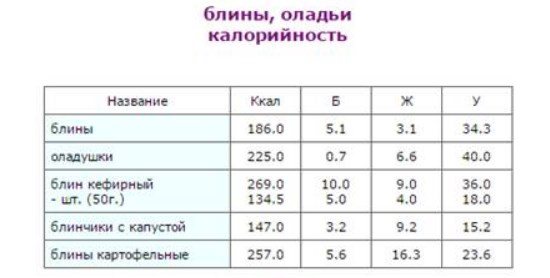
Micro- and macroelements in liver pancakes
Liver fritters contain the following elements: Ash, Water, Sodium, Potassium, Phosphorus, Magnesium, Calcium, Sulfur, Copper, Silicon, Iodine, Manganese, Chromium, Fluorine, Molybdenum, Cobalt, Nickel, Zinc, Iron, Chlorine.
| Micro and macro element | Meaning |
| Zola, Mr. | 1,5 |
| Water, city | 83,8 |
| Sodium, mg | 128,6 |
| Potassium, mg | 251,9 |
| Phosphorus, mg | 342,7 |
| Magnesium, mg | 23 |
| Calcium, mg | 8,7 |
| Sulfur, mg | 249,3 |
| Copper, µg | 3858,1 |
| Silicon, mg | 0,3 |
| Iodine, mcg | 6,4 |
| Manganese, mg | 0,4275 |
| Chromium, µg | 32,6 |
| Fluorine, mcg | 232,4 |
| Molybdenum, mcg | 112,9 |
| Cobalt, µg | 20,4 |
| Nickel, µg | 63,7 |
| Zinc, mg | 5,1539 |
| Iron, mg | 10,1 |
| Chlorine, mg | 211,7 |
Low calorie pancake recipe
You can significantly reduce the calorie content of pancakes by completely replacing milk with 1 liter of water. But they will not be as tasty as with milk. It is better to replace no more than half of the milk with water.
The calorie content of 100 g of pancakes on water will be 135 kcal. The calorie content of each pancake depends on how much the pancake weighs, as well as what is included in its composition - this dish can be prepared with milk, kefir, or mineral water.
Nutritionists offer a recipe for pancakes with the ingredients: 150 g of wheat and spelled flour, 2 eggs, 300 ml of kefir, 2 tablespoons of ricotta cheese, 2-3 tablespoons of olive oil, a pinch of salt and sugar.
Lightly beat all products except flour, gradually add flour and knead the dough without lumps. Leave the dough for half an hour and bake pancakes.
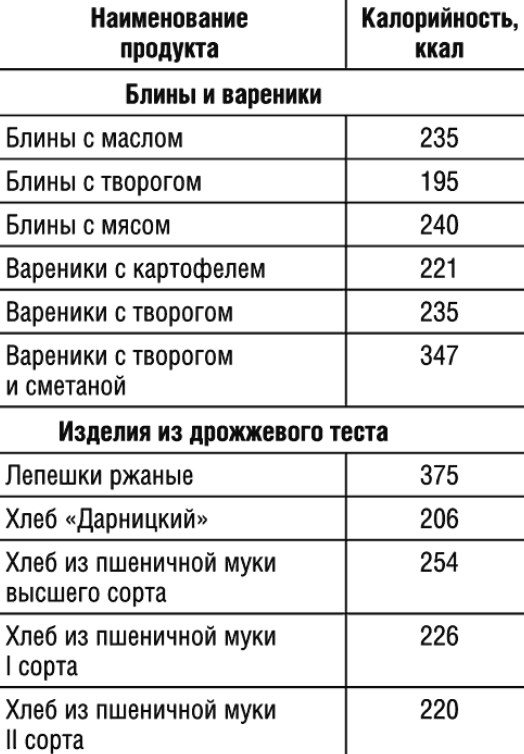
Pancakes with 1 egg: 3 recipes for making delicious and thin pancakes
Anna Ivashkevich, nutritionist, clinical psychologist-dietitian, member of the Union of the National Association of Clinical Nutrition, talks about how to properly and safely eat pancakes before Lent :
Classic pancakes are a product made from flour, water, eggs with added sugar and salt. Once upon a time they were even used in the diet instead of bread. Flour gives us mostly carbohydrates, and only then proteins and some fat. This should be taken into account when preparing and calculating the calorie content of the diet. That is, it is undesirable to replace all meals with pancakes during Maslenitsa - this will negatively affect not only your body, but also your figure.
You can eat from 3 to 6 pancakes in one meal, but, of course, the norm will be different for men and women. For a girl - 3-4 pancakes, for a man - 6 pieces. But in this case, it is necessary to take into account the filling with which you will eat the pancakes.
How to reduce the calorie content of pancakes
Pancakes without filling will be less nutritious. You can partially or completely replace milk with water. Wheat flour can be partially replaced with lower-calorie rye or wholemeal flour, rich in fiber. You can also use oatmeal, buckwheat and flaxseed flour. Healthy varieties of flour are also oatmeal, buckwheat and flaxseed. These reduced-calorie pancakes fill you up without overeating.
It is better to use fruit or berry puree or freshly cut fruits, such as apples, as a filling. And for savory fillings, you can take low-fat cottage cheese, minced boiled chicken or turkey, lean beef, and stewed vegetables.
You can also compromise: use either diet dough or diet fillings.
You need to prepare the pancake dough yourself. Store-bought mixtures are quite high in calories. Instead of eggs, you can use only egg whites, since they contain virtually no fat.
You can reduce the amount of frying oil by using a cast iron or non-stick frying pan. If you add 2-3 tablespoons of vegetable oil to the dough, you can fry pancakes without using fat (before the first pancake, you need to pour one tablespoon of sunflower oil into the frying pan).
It should be remembered that pancakes cannot be stored for a long time, especially if they are filled. The shelf life of pancakes without filling does not exceed 4 hours at room temperature, and in the refrigerator - no more than a day.
If you plan to store filled pancakes, it is better to put them in the freezer immediately after cooking. They can be stored there for several months.
Order of adding ingredients
Pour the eggs beaten with a mixer into a large bowl. This should be done carefully. Then you need to add water and milk. After this, the mixture must be mixed well. Now you can add flour. This should be done in small portions and stirred gradually. Then lumps will not form, which are sure to be present if you prepare the pancake dough in a different sequence.
You will never have a problem with your pancakes being thick or tough like soles. The proposed sequence of adding ingredients will provide the necessary aeration, which will result in a delicate and soft product.
Some more tips for pancake lovers:
Found a violation? Report content
Pancakes: calorie content of various recipes, dietary cooking options
A fragrant, tasty, simple dish, one of the most ancient recipes. A symbol of the sun and receding winter, home comfort and family feast. Pancakes never cease to delight housewives with the variety and simplicity of recipes, various dough options and fillings. The dish can be prepared and served as a main course or dessert, or made into a hearty breakfast or light lunch.
However, people who are watching their extra pounds are rather frightened by the food. It’s scary to even imagine how many calories there are in pancakes seasoned with jam and butter. Nevertheless, there are many ways to prepare a frying pan for different tastes and diets.
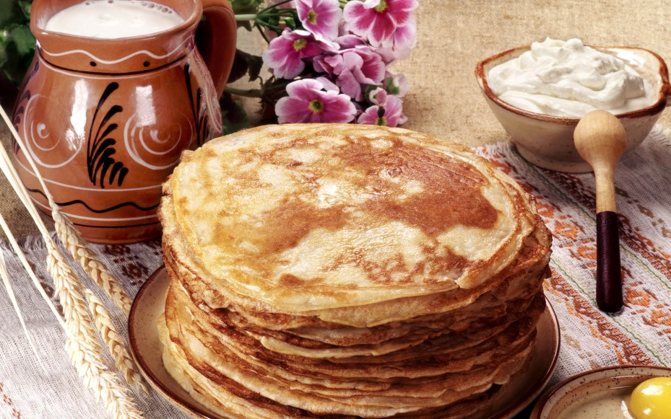
Recipe for pancakes with liver with photo
Kitchen tools:
Ingredients
| Premium flour | 100 g |
| Milk (warm) | 250 ml |
| Chicken eggs | 2 pcs. |
| Granulated sugar | 15 g |
| Salt | taste |
| Liver (beef) | 200 g |
| Carrots (small) | 0.5-1 pcs. |
| Butter | 20 g |
| Vegetable oil | 35 g |
| Black pepper (ground) | taste |
Step-by-step preparation of pancakes with liver
Video recipe for delicious stuffed pancakes
We recommend watching this video, in which you can see how to make homemade pancakes with aromatic liver filling, which are perfect as a light but satisfying snack.
Calorie content of pancakes
The classic set for preparing a dish is flour, milk, egg, salt, sugar, soda for fluffiness. All of the following ingredients have a beneficial effect on the body:
- flour is a supplier of minerals and vitamins (oat, buckwheat, wheat pancakes have a unique chemical composition),
- milk brings calcium and vitamin D (strengthens bones, improves the functioning of the nervous system),
- The egg contains folic acid, lecithin, and helps normalize fat metabolism.
According to the given recipe (milk - 400 g, wheat flour - 150 g, egg - 1 pc., sugar - 1 tbsp., soda with vinegar - ¼ tsp.), the calorie content of pancakes with milk and sugar will be 134 kcal (100 d), with vegetable oil (3 tbsp.) the indicator will increase to 170.
Depending on the proportions of the components and the fat content of the milk, the energy value of pancakes can reach 186 kcal per 100 grams. The calorie content of 1 pancake with milk weighing 45-50 g (1 piece) includes about 93 units. When adding a creamy component, jam or sour cream, the resulting calorie content is around 233 kcal (100 g) or more.
Pancake batter
Any cooking option involves choosing two main components: the type of flour and the liquid base for kneading. Pancakes can change their calorie content up or down depending on the ingredients selected for the test.
First of all, let's look at the different options with flour. Wheat pancakes give an average of 186-197 kcal (100 g). The calorie content of corn is 221 units. Buckwheat pancakes (with kefir) include 170 kcal (100 g), when mixed with wheat flour in different proportions - 190-229 units.
The calorie content of oat pancakes is 170 units (100 g), the addition of wheat flour raises the indicators to 227 kcal. The nutritional value of a vegetable zucchini pancake may be lower than the given data - 131 kcal (100 g).
Let's move on to the liquid base for mixing. Pancake dough can be prepared using ingredients of different calorie content (kcal per 100 grams):
- on mineral water – 90-105,
- on water – 115-135,
- on serum – 131,
- on beer – 163,
- on kefir (2%) – 174-200,
- with milk – 170-230.
When kneading in water, fried pancake (1 piece) gives the lowest calorie content: 61 kcal (45 g). It is worth remembering that it is in your hands to prepare thin homemade pancakes, the average weight of which is reduced to 35-40 grams, which means the energy value becomes less.
Pancake filling
Stuffed food options have higher calorie content, but the numbers can be adjusted by giving preference to low-fat ingredients.
Pancakes are usually prepared as a main dish (calories - 100 g):
- with mushrooms – 218-220,
- with salmon – 311,
- with red caviar – 324,
- with egg (on kefir) – 222,
- with meat – 370,
- with meat and rice – 250,
- with minced chicken – 165-265,
- with minced beef and pork – 270,
- with minced beef – 194-260,
- with minced pork – 300-490,
- with chicken and mushrooms – 241,
- with ham and cheese – 382,
- with cheese – 348,
- with liver – 170-197,
- with cabbage – 117-147.
For dessert options or breakfast dishes, sweet filling options are used (calorie content per 100 g):
- with condensed milk – 206,
- with honey – 350,
- with apple – 256,
- with jam – 185-245.
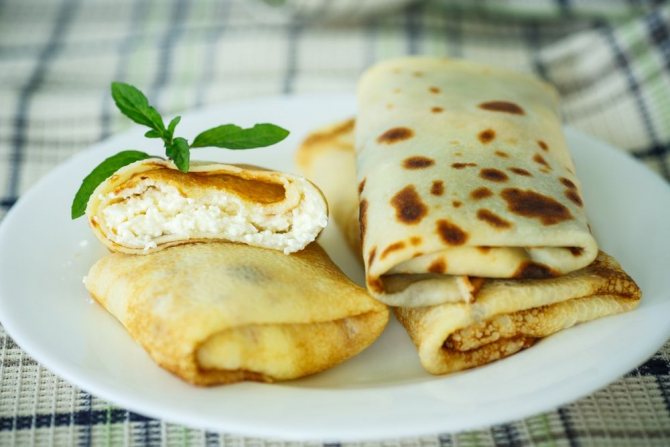
The most popular is pancake with cottage cheese. Calorie content varies depending on the fat content of the filling: for 9% the figure is approximately 185 kcal (100 g), a higher percentage brings the nutritional value to 230-330 units. Sometimes raisins are added to the recipe to improve the taste, but be prepared to add 7-10 calories to the dish.
So the calorie content of 1 pancake with cottage cheese (150 g) with sour cream is up to 294 units.
Ingredients for pancakes without butter
| Blue milk 3.5% Kobrin Dairy family | 400 g |
| Chicken egg (Frying omelette) | 100 g |
| cane brown sugar | 50 g |
| Table salt | 3 g |
| Baking soda | 5 g |
| Wheat flour | 320 g |
| Olive oil | 25 g |
Pancakes that need to be fried without oil! Ingredients: - 2 cups of milk - 2 eggs - 2 tablespoons of sugar - 1 salt - 1 teaspoon of baking soda - 2 cups of flour - 1/4 cup of vegetable oil Mix everything and beat with a mixer! Fry in a frying pan without oil, don’t even grease, they fry very quickly, literally 20 seconds on each side! Serve with sour cream, jam and berries.
Nutritional value and chemical composition of “pancakes without butter.”
| Nutrient | Quantity | Norm** | % of the norm in 100 g | % of the norm in 100 kcal | 100% normal |
| Calorie content | 207.8 kcal | 1684 kcal | 12.3% | 5.9% | 810 g |
| Squirrels | 6.3 g | 76 g | 8.3% | 4% | 1206 g |
| Fats | 5.9 g | 56 g | 10.5% | 5.1% | 949 g |
| Carbohydrates | 32.4 g | 219 g | 14.8% | 7.1% | 676 g |
| Alimentary fiber | 1.3 g | 20 g | 6.5% | 3.1% | 1538 g |
| Water | 52 g | 2273 g | 2.3% | 1.1% | 4371 g |
| Vitamins | |||||
| Vitamin A, RE | 43.8 mcg | 900 mcg | 4.9% | 2.4% | 2055 g |
| beta carotene | 0.015 mg | 5 mg | 0.3% | 0.1% | 33333 g |
| Vitamin B1, thiamine | 0.086 mg | 1.5 mg | 5.7% | 2.7% | 1744 g |
| Vitamin B2, riboflavin | 0.131 mg | 1.8 mg | 7.3% | 3.5% | 1374 g |
| Vitamin B4, choline | 57.25 mg | 500 mg | 11.5% | 5.5% | 873 g |
| Vitamin B5, pantothenic | 0.432 mg | 5 mg | 8.6% | 4.1% | 1157 g |
| Vitamin B6, pyridoxine | 0.1 mg | 2 mg | 5% | 2.4% | 2000 g |
| Vitamin B9, folates | 12.776 mcg | 400 mcg | 3.2% | 1.5% | 3131 g |
| Vitamin B12, cobalamin | 0.237 mcg | 3 mcg | 7.9% | 3.8% | 1266 g |
| Vitamin C, ascorbic acid | 0.58 mg | 90 mg | 0.6% | 0.3% | 15517 g |
| Vitamin D, calciferol | 0.268 mcg | 10 mcg | 2.7% | 1.3% | 3731 g |
| Vitamin E, alpha tocopherol, TE | 0.987 mg | 15 mg | 6.6% | 3.2% | 1520 g |
| Vitamin H, biotin | 3.333 mcg | 50 mcg | 6.7% | 3.2% | 1500 g |
| Vitamin RR, NE | 1.4855 mg | 20 mg | 7.4% | 3.6% | 1346 g |
| Macronutrients | |||||
| Potassium, K | 144.03 mg | 2500 mg | 5.8% | 2.8% | 1736 |
| Calcium, Ca | 18.58 mg | 1000 mg | 1.9% | 0.9% | 5382 g |
| Silicon, Si | 1.432 mg | 30 mg | 4.8% | 2.3% | 2095 g |
| Magnesium, Mg | 15.03 mg | 400 mg | 3.8% | 1.8% | 2661 g |
| Sodium, Na | 323.53 mg | 1300 mg | 24.9% | 12% | 402 g |
| Sera, S | 58.32 mg | 1000 mg | 5.8% | 2.8% | 1715 g |
| Phosphorus, Ph | 94.1 mg | 800 mg | 11.8% | 5.7% | 850 g |
| Chlorine, Cl | 274.13 mg | 2300 mg | 11.9% | 5.7% | 839 g |
| Microelements | |||||
| Bor, B | 13.2 mcg | ||||
| Vanadium, V | 32.21 mcg |
